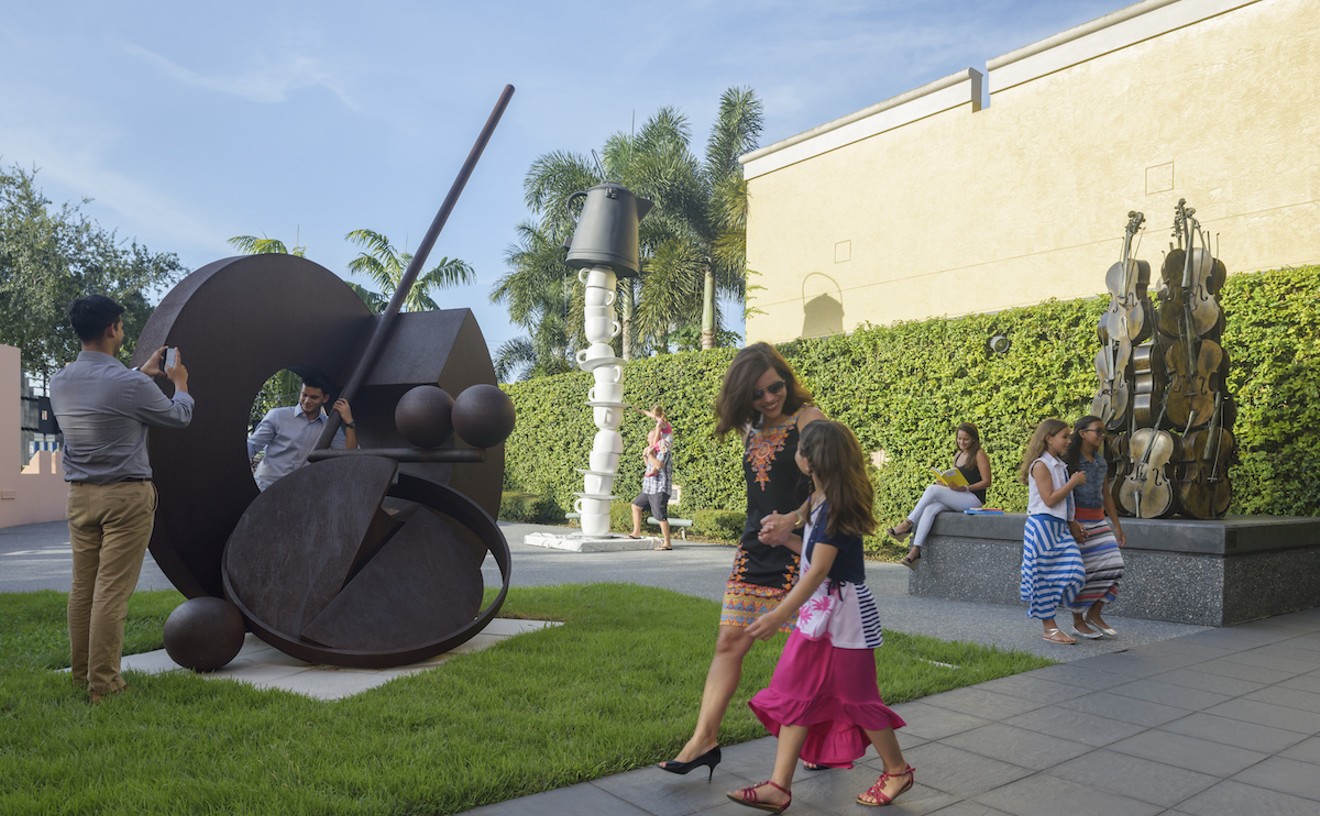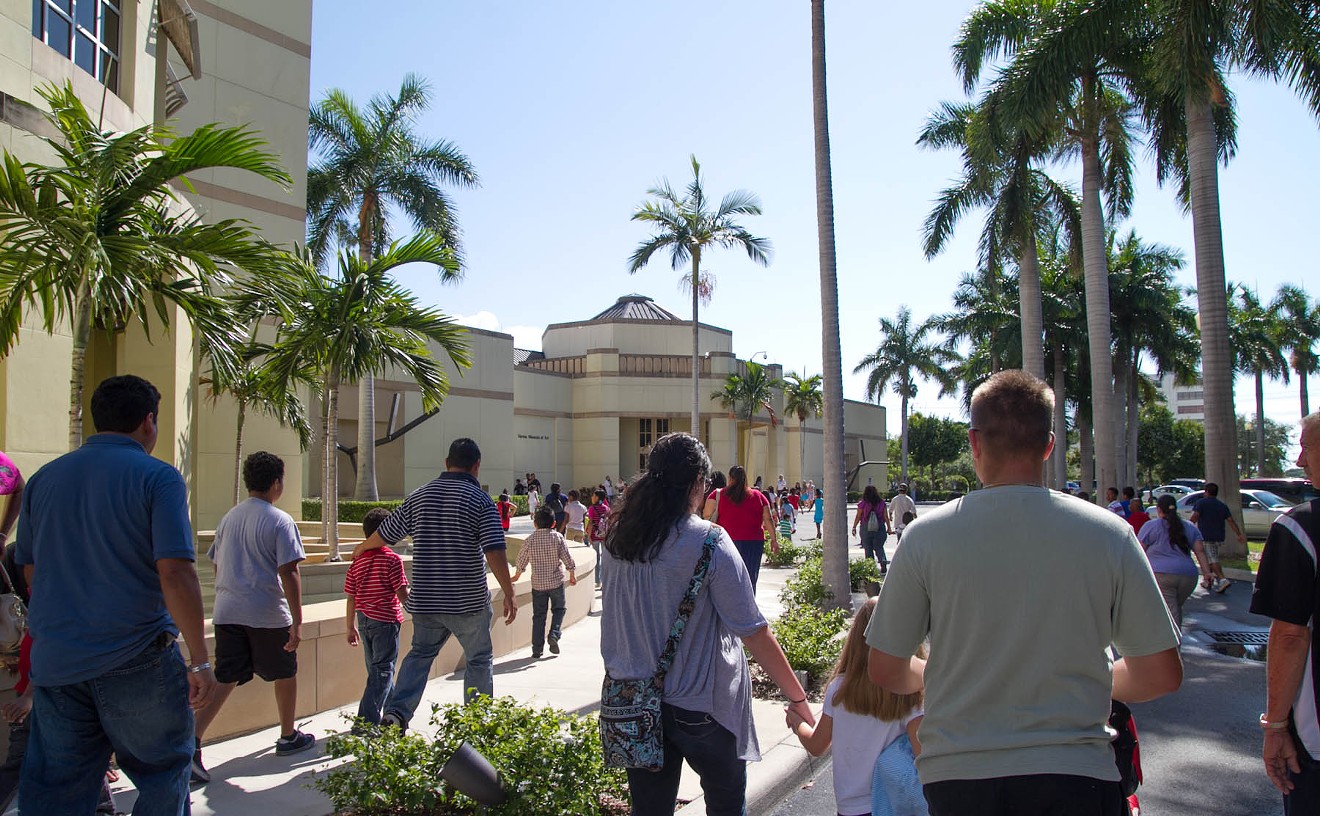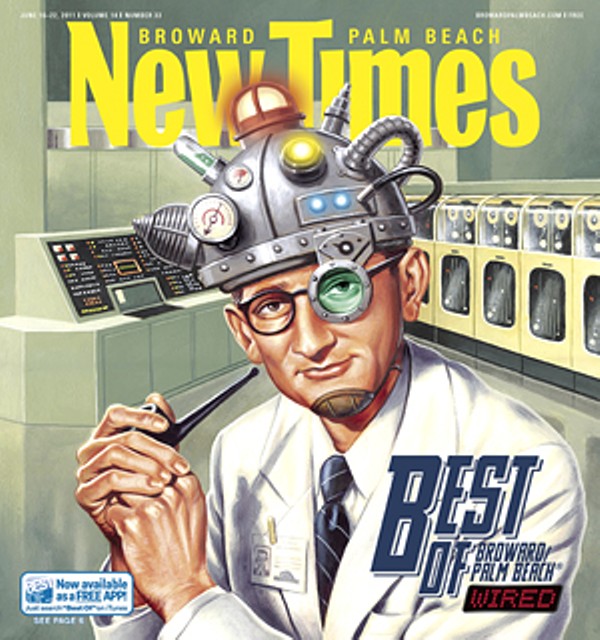It's rare to find two artists whose styles are as in tune as Jan Kolenda and Bob Bagley's, and it's rarer still to run across a museum show that plays them off each other as well as this joint exhibition at the Coral Springs Museum. Kolenda works with clay. Bagley is a woodworker. Each had segments of the exhibition devoted to his or her own work, along with a handful of pieces the two artists collaborated on. The marvel, though, is that the works mingled as freely as if they had sprung from the same sensibility — one that prizes the organic over the inorganic, form over function, beauty over practicality.
Best Duo Art Exhibition
"Inspired by Nature: Beyond Function"
Best Solo Art Exhibition
"Elvis at 21: Photographs by Alfred Wertheimer"

Photography is all about capturing the moment, and no show this year captured its cultural moment as well as this collection of photographs from 1956. That's when a beautiful young man named Elvis Presley was just two years into his soon-to-be tumultuous career and poised to change American pop forever. Alfred Wertheimer was a young photographer-for-hire who had never even heard of Elvis when he spent two brief periods with the singer. But the lensman's instincts were such that his hungry eye was able to catch images that resonate to this day. The exhibition was full of privileged moments filtered through a photographer who knew he was onto something, such as the justly famous image of the singer kissing a young woman he had just met in a hotel diner. The show let us bask in the idea of Elvis as an avatar of potential — Elvis caught in the process of becoming himself.
- 501 Plaza Real, Boca Raton, 33432 Map
- 561-392-2500
- www.bocamuseum.org
Best Photography Exhibition
"Avedon Fashion 1944-2000"

The best photographers succeed at freezing highly specific instants — arresting the flow of time and isolating fragments that refine and define it. Richard Avedon, who was one of the best of the best, defined whole eras of our visual culture through his camera lens. This retrospective at the Norton included more than 150 photographs he took for Harper's Bazaar, Vogue, and the New Yorker (where he was, amazingly, the first staff photographer). The focus may be fashion, but the exhibition and its hefty catalog handily transcend that rarefied world to preserve glimpses of crystallized history. Starting on location in the 1950s and later moving into the studio environment, Avedon rightly realized that fashion isn't just about the clothes; it's about the personalities that inhabit them, and over the course of decades, he mastered the art of distilling personality to its ineffable essence.
- 1451 S. Olive Ave., West Palm Beach, 33401 Map
- 561-832-5196
- www.norton.org
Best Festival
Stitch Rock

It could be said that we have two seasons in Florida — Hurricane Season and Not Hurricane Season. But that would be leaving out an important time of year: Festival Season. Our great festivals include the likes of SunFest, Beerfest, and Garlic Fest, but the art festivals have never been highlights. Stitch Rock set out to change that. With crafts that would give Grandma fits — made by tattooed grrls who would give her nightmares — Stitch Rock provides a venue for the next generation of crafters. Indie shoppers form a line around the Old School Square in Delray Beach hoping to get a free door prize. For the unlucky ones, the vintage goods, upcycled crafts, and gourmet cupcakes make everything OK again. And although it may be only 4 years old, Stitch Rock is already a Festival Season fixture, with the fifth installment already scheduled for October 1.
- 51 N. Swinton Ave., Delray Beach, 33444 Map
- 561-243-7922
- www.oldschool.org
Best Painting Exhibition
"Reclaimed: Paintings From the Collection of Jacques Goudstikker"

History joined forces with art to make this show at the Norton more than just a bunch of paintings. The 40 works included were part of the enormous collection of Jacques Goudstikker, a prosperous Dutch dealer whose inventory was confiscated during World War II by Nazis under second-in-command Hermann Göring. Among Goudstikker's specialties were works from the Italian Renaissance, early Dutch and German paintings, Dutch and Flemish paintings from the 17th Century, French and Italian rococo works, and 19th-century northern European paintings. It took more than half a century for a fraction of the looted art to be returned to the dealer's estate, and fortunately works by such masters as Peter Paul Rubens and Jacob van Ruisdael survived to become part of Goudstikker's Hollywood-worthy adventure story.
- 1451 S. Olive Ave., West Palm Beach, 33401 Map
- 561-832-5196
- www.norton.org
Best Art Museum
Boca Raton Museum of Art

A great museum must perform a delicate balancing act of satisfying the public while also expanding and enhancing that same public's cultural literacy. The Boca Museum has long done an exceptionally fine job of giving the public both what it wants and what it doesn't even know it needs. That has especially been true under the leadership of Executive Director George S. Bolge, who is leaving this summer after roughly 16 years at the museum. During his tenure, Bolge has programmed his share of crowd pleasers, including artists as disparate as Picasso, Duane Hanson, and Purvis Young. But he has invariably emphasized less-familiar artists as well. In the past year alone, he has paired an exhibition of Alfred Wertheimer's photographs of Elvis Presley at 21 with a retrospective of relatively obscure American painter Stanley Boxer; coupled a blockbuster M.C. Escher show with a much smaller one focusing on impressionist Mary Cassatt's works on paper; and juxtaposed Italian artist Valerio Adami with well-known American photorealist painter Robert Cottingham. Most recently, he coupled a flashy "CUT! Costume and the Cinema" show with a horizon-expanding look at California impressionism. Let's hope the museum carries on the great tradition he established.
- 501 Plaza Real, Boca Raton, 33432 Map
- 561-392-2500
- www.bocamuseum.org
Best Group Art Exhibition
"Latin American Art From the Collection of Pearl and Stanley Goodman" and "Recent Acquisitions From the Museum's Latin American Art Collection"
Approached individually, either one of these two ambitious surveys of Latin American art would be a force to reckon with. Seen together as essentially one big show, which is how the museum presented them, they achieved even greater breadth and depth. The breadth came from the historical context provided by the Goodmans' collection, here represented by 74 works by 46 artists. Dr. and Mrs. Goodman have been seriously collecting Latin American art for roughly two decades; their abundant taste and discernment are evident in the choices they've made, from great Mexican muralists Diego Rivera and David Alfaro Siqueiros to such surrealist masters as Cuban Wifredo Lam and Chilean Roberto Matta. The smaller, ostensibly secondary show of 56 works by 41 artists, assembled by in-house curator Jorge Hilker Santis from the museum's sizable permanent collection, provided depth as well as an emphasis on more contemporary work. As a sweeping study in contrasts and comparisons, the two exhibitions constituted an unbeatable combination.
Best Exhibition Title
"Frances Trombly: Paintings"

For starters, there were no actual paintings in this daring little show at the equally daring little downtown Fort Lauderdale gallery known as Girls' Club. Instead, Frances Trombly's installation, which takes up the gallery's entire first-floor display space, is a suite of pieces designed to make us think about painting. Each of the linked works is a blank "canvas" made of hand-stitched fabric and either placed face-down on the floor or propped against a wall, back to us. Like a Zen koan, the title "Frances Trombly: Paintings" is meant to jar us onto another plane of awareness, where we start thinking about (and questioning) our ideas about what constitutes art and what does not.
- 117 NE Second St., Fort Lauderdale, 33301 Map
- 954-828-9151
- www.girlsclubcollection.org
Best Art Event
FAT Village Art Walk
It's lively, it happens every month, and you've probably never heard of it. When you're done explaining to your skeptical friends what FAT stands for (Flagler Arts and Technology — any questions?), stop by the intersection of NW Fifth Street and NW First Avenue and get ready to explore the Wild West of the Florida art world. Gawk at the scale of the Project Lofts, which houses big-name temporary exhibitions; release your inner child at the Puppet Network headquarters across the street. Get your yipster-bobo thrills at Collide Factory (at First and Sistrunk), where lively music and art meets a Google-cool office environment. Two black-box theaters within clapping distance premiere new shows. Even the neighborhood holdouts get in on the action: Paul Fioretti at South Florida Window Lift (First and Fifth) shows off the sculptures he welds from discarded machine parts. When you're done, head to Maguires for a heady pint and talk about what that looping video of a screaming naked man really meant.
Best Public Art
Lake Worth Street Painting Festival
Once a year, renowned artists crouch down on the asphalt alongside high school kids and amateurs, everyone covered in chalk and happily sunburned. The streets of downtown Lake Worth are filled with crowds guzzling funnel cake and beer, watching wide-eyed as the painters coax magic from the pavement. While admiring the brilliant artwork, you might also spot belly-dancing hippies, a musician playing a hand saw, kids in strollers, and anarchists sipping kava. Welcome to the glory that is Lake Worth.






